Commercial Law Report: Analyzing Agency in Mudkey's Business Deal
VerifiedAdded on 2020/03/23
|8
|2684
|57
Report
AI Summary
This report provides a comprehensive analysis of agency law, focusing on the concepts of implied and apparent authority within the context of a commercial law scenario. It examines the legal relationship between a principal and an agent, exploring the circumstances under which a principal is bound by the actions of their agent. The report delves into relevant case law, such as Watteau v Fenwick and Freeman and Lockyer v Buckhurst Park Properties (Mangal) Ltd, to illustrate the principles of agency and authority. The application section analyzes a case study involving Mudkey and Kevin, assessing whether Mudkey is bound by Kevin's actions. The report concludes that Kevin possessed both actual implied authority and apparent authority, making Mudkey responsible for the transaction. Furthermore, the report examines the scope of authority and how it changes based on the type of agency, differentiating between actual and ostensible authority and highlighting the legal responsibilities of principals and agents in various scenarios.
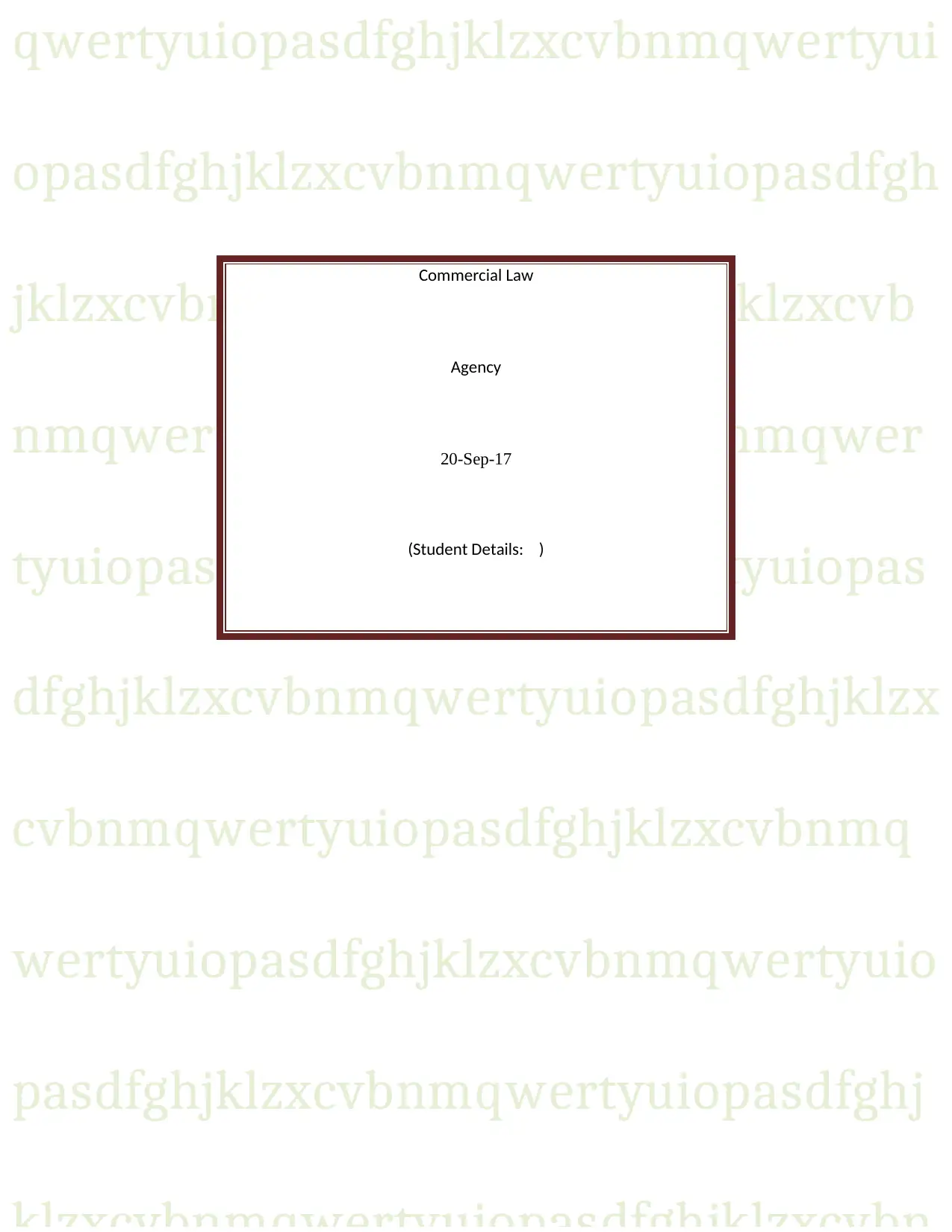
qwertyuiopasdfghjklzxcvbnmqwertyui
opasdfghjklzxcvbnmqwertyuiopasdfgh
jklzxcvbnmqwertyuiopasdfghjklzxcvb
nmqwertyuiopasdfghjklzxcvbnmqwer
tyuiopasdfghjklzxcvbnmqwertyuiopas
dfghjklzxcvbnmqwertyuiopasdfghjklzx
cvbnmqwertyuiopasdfghjklzxcvbnmq
wertyuiopasdfghjklzxcvbnmqwertyuio
pasdfghjklzxcvbnmqwertyuiopasdfghj
Commercial Law
Agency
20-Sep-17
(Student Details: )
opasdfghjklzxcvbnmqwertyuiopasdfgh
jklzxcvbnmqwertyuiopasdfghjklzxcvb
nmqwertyuiopasdfghjklzxcvbnmqwer
tyuiopasdfghjklzxcvbnmqwertyuiopas
dfghjklzxcvbnmqwertyuiopasdfghjklzx
cvbnmqwertyuiopasdfghjklzxcvbnmq
wertyuiopasdfghjklzxcvbnmqwertyuio
pasdfghjklzxcvbnmqwertyuiopasdfghj
Commercial Law
Agency
20-Sep-17
(Student Details: )
Paraphrase This Document
Need a fresh take? Get an instant paraphrase of this document with our AI Paraphraser
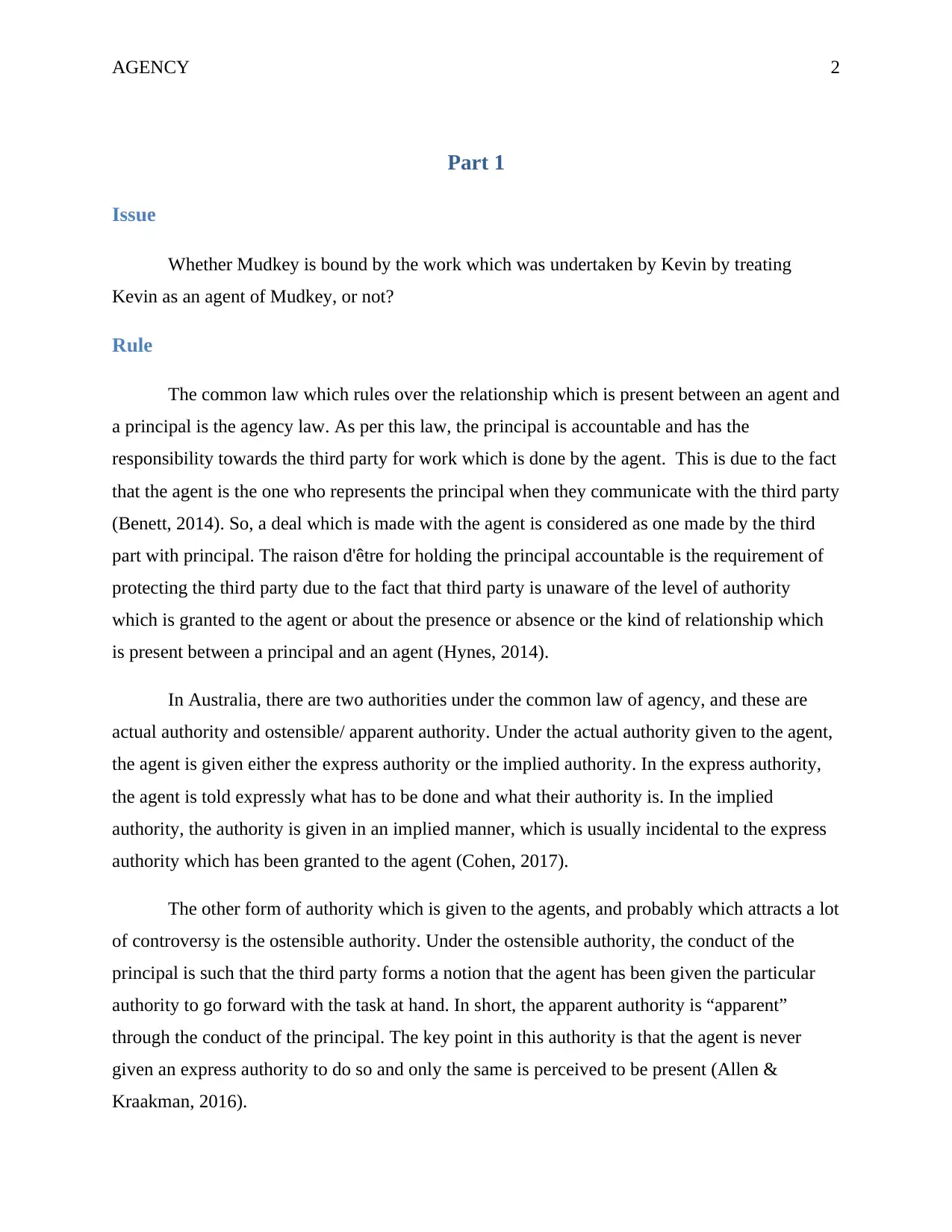
AGENCY 2
Part 1
Issue
Whether Mudkey is bound by the work which was undertaken by Kevin by treating
Kevin as an agent of Mudkey, or not?
Rule
The common law which rules over the relationship which is present between an agent and
a principal is the agency law. As per this law, the principal is accountable and has the
responsibility towards the third party for work which is done by the agent. This is due to the fact
that the agent is the one who represents the principal when they communicate with the third party
(Benett, 2014). So, a deal which is made with the agent is considered as one made by the third
part with principal. The raison d'être for holding the principal accountable is the requirement of
protecting the third party due to the fact that third party is unaware of the level of authority
which is granted to the agent or about the presence or absence or the kind of relationship which
is present between a principal and an agent (Hynes, 2014).
In Australia, there are two authorities under the common law of agency, and these are
actual authority and ostensible/ apparent authority. Under the actual authority given to the agent,
the agent is given either the express authority or the implied authority. In the express authority,
the agent is told expressly what has to be done and what their authority is. In the implied
authority, the authority is given in an implied manner, which is usually incidental to the express
authority which has been granted to the agent (Cohen, 2017).
The other form of authority which is given to the agents, and probably which attracts a lot
of controversy is the ostensible authority. Under the ostensible authority, the conduct of the
principal is such that the third party forms a notion that the agent has been given the particular
authority to go forward with the task at hand. In short, the apparent authority is “apparent”
through the conduct of the principal. The key point in this authority is that the agent is never
given an express authority to do so and only the same is perceived to be present (Allen &
Kraakman, 2016).
Part 1
Issue
Whether Mudkey is bound by the work which was undertaken by Kevin by treating
Kevin as an agent of Mudkey, or not?
Rule
The common law which rules over the relationship which is present between an agent and
a principal is the agency law. As per this law, the principal is accountable and has the
responsibility towards the third party for work which is done by the agent. This is due to the fact
that the agent is the one who represents the principal when they communicate with the third party
(Benett, 2014). So, a deal which is made with the agent is considered as one made by the third
part with principal. The raison d'être for holding the principal accountable is the requirement of
protecting the third party due to the fact that third party is unaware of the level of authority
which is granted to the agent or about the presence or absence or the kind of relationship which
is present between a principal and an agent (Hynes, 2014).
In Australia, there are two authorities under the common law of agency, and these are
actual authority and ostensible/ apparent authority. Under the actual authority given to the agent,
the agent is given either the express authority or the implied authority. In the express authority,
the agent is told expressly what has to be done and what their authority is. In the implied
authority, the authority is given in an implied manner, which is usually incidental to the express
authority which has been granted to the agent (Cohen, 2017).
The other form of authority which is given to the agents, and probably which attracts a lot
of controversy is the ostensible authority. Under the ostensible authority, the conduct of the
principal is such that the third party forms a notion that the agent has been given the particular
authority to go forward with the task at hand. In short, the apparent authority is “apparent”
through the conduct of the principal. The key point in this authority is that the agent is never
given an express authority to do so and only the same is perceived to be present (Allen &
Kraakman, 2016).
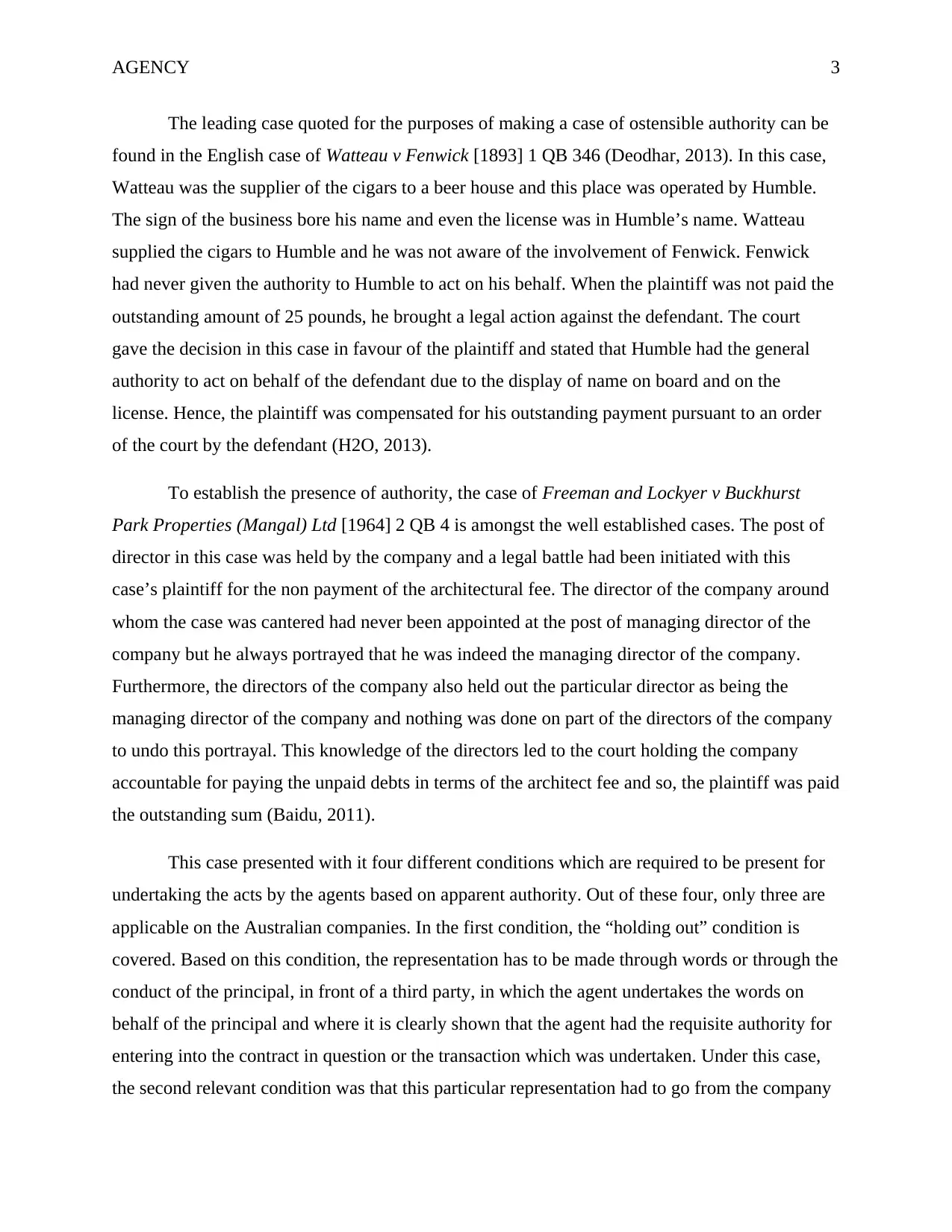
AGENCY 3
The leading case quoted for the purposes of making a case of ostensible authority can be
found in the English case of Watteau v Fenwick [1893] 1 QB 346 (Deodhar, 2013). In this case,
Watteau was the supplier of the cigars to a beer house and this place was operated by Humble.
The sign of the business bore his name and even the license was in Humble’s name. Watteau
supplied the cigars to Humble and he was not aware of the involvement of Fenwick. Fenwick
had never given the authority to Humble to act on his behalf. When the plaintiff was not paid the
outstanding amount of 25 pounds, he brought a legal action against the defendant. The court
gave the decision in this case in favour of the plaintiff and stated that Humble had the general
authority to act on behalf of the defendant due to the display of name on board and on the
license. Hence, the plaintiff was compensated for his outstanding payment pursuant to an order
of the court by the defendant (H2O, 2013).
To establish the presence of authority, the case of Freeman and Lockyer v Buckhurst
Park Properties (Mangal) Ltd [1964] 2 QB 4 is amongst the well established cases. The post of
director in this case was held by the company and a legal battle had been initiated with this
case’s plaintiff for the non payment of the architectural fee. The director of the company around
whom the case was cantered had never been appointed at the post of managing director of the
company but he always portrayed that he was indeed the managing director of the company.
Furthermore, the directors of the company also held out the particular director as being the
managing director of the company and nothing was done on part of the directors of the company
to undo this portrayal. This knowledge of the directors led to the court holding the company
accountable for paying the unpaid debts in terms of the architect fee and so, the plaintiff was paid
the outstanding sum (Baidu, 2011).
This case presented with it four different conditions which are required to be present for
undertaking the acts by the agents based on apparent authority. Out of these four, only three are
applicable on the Australian companies. In the first condition, the “holding out” condition is
covered. Based on this condition, the representation has to be made through words or through the
conduct of the principal, in front of a third party, in which the agent undertakes the words on
behalf of the principal and where it is clearly shown that the agent had the requisite authority for
entering into the contract in question or the transaction which was undertaken. Under this case,
the second relevant condition was that this particular representation had to go from the company
The leading case quoted for the purposes of making a case of ostensible authority can be
found in the English case of Watteau v Fenwick [1893] 1 QB 346 (Deodhar, 2013). In this case,
Watteau was the supplier of the cigars to a beer house and this place was operated by Humble.
The sign of the business bore his name and even the license was in Humble’s name. Watteau
supplied the cigars to Humble and he was not aware of the involvement of Fenwick. Fenwick
had never given the authority to Humble to act on his behalf. When the plaintiff was not paid the
outstanding amount of 25 pounds, he brought a legal action against the defendant. The court
gave the decision in this case in favour of the plaintiff and stated that Humble had the general
authority to act on behalf of the defendant due to the display of name on board and on the
license. Hence, the plaintiff was compensated for his outstanding payment pursuant to an order
of the court by the defendant (H2O, 2013).
To establish the presence of authority, the case of Freeman and Lockyer v Buckhurst
Park Properties (Mangal) Ltd [1964] 2 QB 4 is amongst the well established cases. The post of
director in this case was held by the company and a legal battle had been initiated with this
case’s plaintiff for the non payment of the architectural fee. The director of the company around
whom the case was cantered had never been appointed at the post of managing director of the
company but he always portrayed that he was indeed the managing director of the company.
Furthermore, the directors of the company also held out the particular director as being the
managing director of the company and nothing was done on part of the directors of the company
to undo this portrayal. This knowledge of the directors led to the court holding the company
accountable for paying the unpaid debts in terms of the architect fee and so, the plaintiff was paid
the outstanding sum (Baidu, 2011).
This case presented with it four different conditions which are required to be present for
undertaking the acts by the agents based on apparent authority. Out of these four, only three are
applicable on the Australian companies. In the first condition, the “holding out” condition is
covered. Based on this condition, the representation has to be made through words or through the
conduct of the principal, in front of a third party, in which the agent undertakes the words on
behalf of the principal and where it is clearly shown that the agent had the requisite authority for
entering into the contract in question or the transaction which was undertaken. Under this case,
the second relevant condition was that this particular representation had to go from the company
⊘ This is a preview!⊘
Do you want full access?
Subscribe today to unlock all pages.

Trusted by 1+ million students worldwide
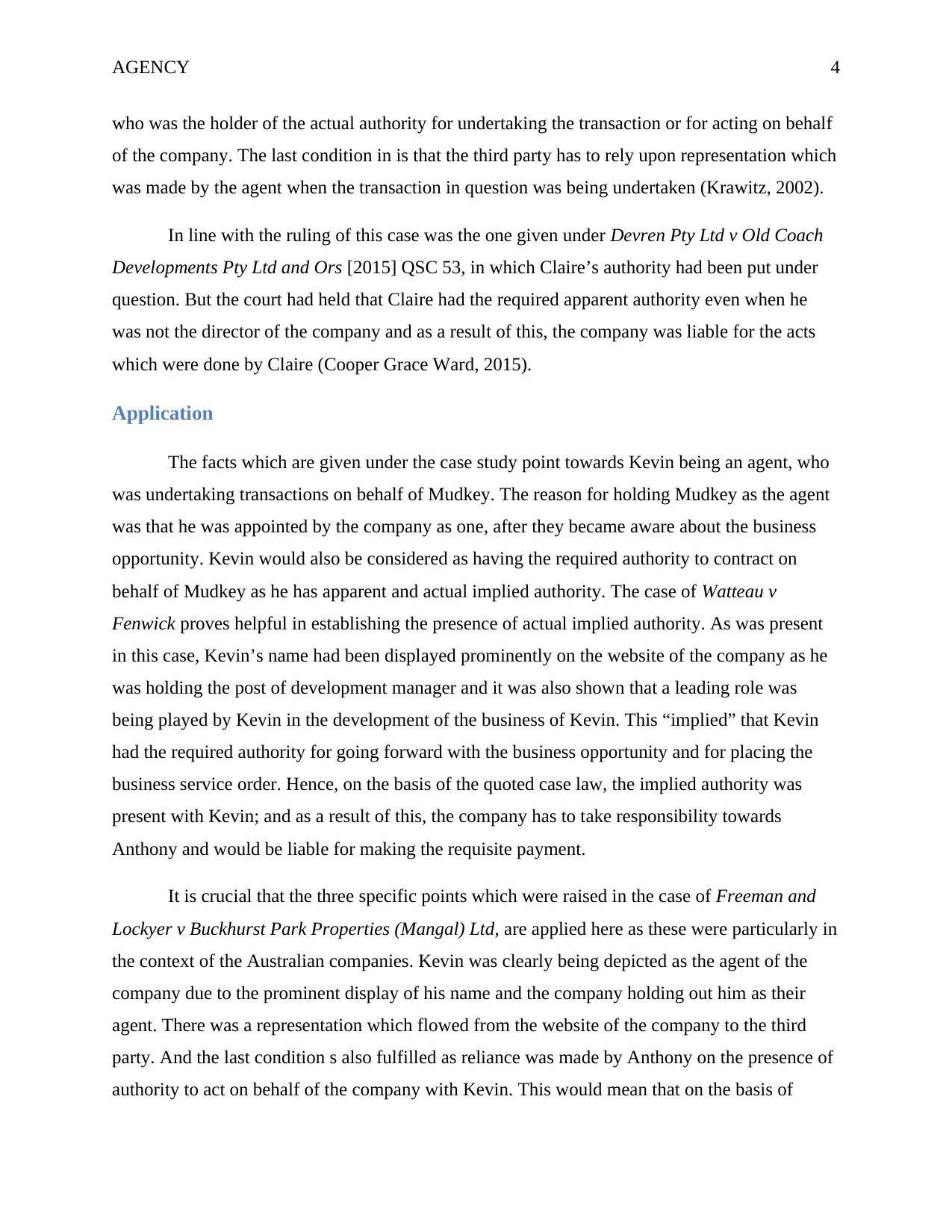
AGENCY 4
who was the holder of the actual authority for undertaking the transaction or for acting on behalf
of the company. The last condition in is that the third party has to rely upon representation which
was made by the agent when the transaction in question was being undertaken (Krawitz, 2002).
In line with the ruling of this case was the one given under Devren Pty Ltd v Old Coach
Developments Pty Ltd and Ors [2015] QSC 53, in which Claire’s authority had been put under
question. But the court had held that Claire had the required apparent authority even when he
was not the director of the company and as a result of this, the company was liable for the acts
which were done by Claire (Cooper Grace Ward, 2015).
Application
The facts which are given under the case study point towards Kevin being an agent, who
was undertaking transactions on behalf of Mudkey. The reason for holding Mudkey as the agent
was that he was appointed by the company as one, after they became aware about the business
opportunity. Kevin would also be considered as having the required authority to contract on
behalf of Mudkey as he has apparent and actual implied authority. The case of Watteau v
Fenwick proves helpful in establishing the presence of actual implied authority. As was present
in this case, Kevin’s name had been displayed prominently on the website of the company as he
was holding the post of development manager and it was also shown that a leading role was
being played by Kevin in the development of the business of Kevin. This “implied” that Kevin
had the required authority for going forward with the business opportunity and for placing the
business service order. Hence, on the basis of the quoted case law, the implied authority was
present with Kevin; and as a result of this, the company has to take responsibility towards
Anthony and would be liable for making the requisite payment.
It is crucial that the three specific points which were raised in the case of Freeman and
Lockyer v Buckhurst Park Properties (Mangal) Ltd, are applied here as these were particularly in
the context of the Australian companies. Kevin was clearly being depicted as the agent of the
company due to the prominent display of his name and the company holding out him as their
agent. There was a representation which flowed from the website of the company to the third
party. And the last condition s also fulfilled as reliance was made by Anthony on the presence of
authority to act on behalf of the company with Kevin. This would mean that on the basis of
who was the holder of the actual authority for undertaking the transaction or for acting on behalf
of the company. The last condition in is that the third party has to rely upon representation which
was made by the agent when the transaction in question was being undertaken (Krawitz, 2002).
In line with the ruling of this case was the one given under Devren Pty Ltd v Old Coach
Developments Pty Ltd and Ors [2015] QSC 53, in which Claire’s authority had been put under
question. But the court had held that Claire had the required apparent authority even when he
was not the director of the company and as a result of this, the company was liable for the acts
which were done by Claire (Cooper Grace Ward, 2015).
Application
The facts which are given under the case study point towards Kevin being an agent, who
was undertaking transactions on behalf of Mudkey. The reason for holding Mudkey as the agent
was that he was appointed by the company as one, after they became aware about the business
opportunity. Kevin would also be considered as having the required authority to contract on
behalf of Mudkey as he has apparent and actual implied authority. The case of Watteau v
Fenwick proves helpful in establishing the presence of actual implied authority. As was present
in this case, Kevin’s name had been displayed prominently on the website of the company as he
was holding the post of development manager and it was also shown that a leading role was
being played by Kevin in the development of the business of Kevin. This “implied” that Kevin
had the required authority for going forward with the business opportunity and for placing the
business service order. Hence, on the basis of the quoted case law, the implied authority was
present with Kevin; and as a result of this, the company has to take responsibility towards
Anthony and would be liable for making the requisite payment.
It is crucial that the three specific points which were raised in the case of Freeman and
Lockyer v Buckhurst Park Properties (Mangal) Ltd, are applied here as these were particularly in
the context of the Australian companies. Kevin was clearly being depicted as the agent of the
company due to the prominent display of his name and the company holding out him as their
agent. There was a representation which flowed from the website of the company to the third
party. And the last condition s also fulfilled as reliance was made by Anthony on the presence of
authority to act on behalf of the company with Kevin. This would mean that on the basis of
Paraphrase This Document
Need a fresh take? Get an instant paraphrase of this document with our AI Paraphraser
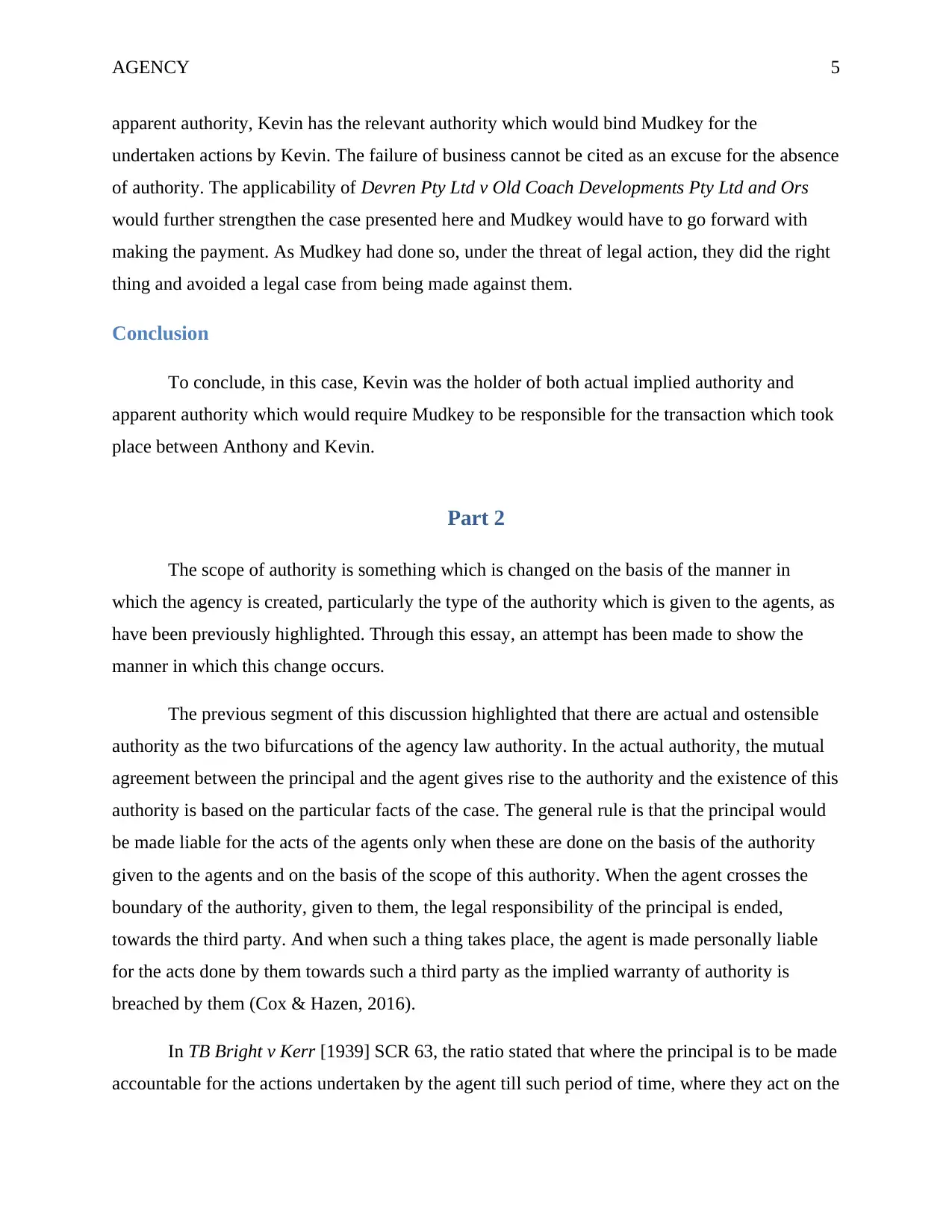
AGENCY 5
apparent authority, Kevin has the relevant authority which would bind Mudkey for the
undertaken actions by Kevin. The failure of business cannot be cited as an excuse for the absence
of authority. The applicability of Devren Pty Ltd v Old Coach Developments Pty Ltd and Ors
would further strengthen the case presented here and Mudkey would have to go forward with
making the payment. As Mudkey had done so, under the threat of legal action, they did the right
thing and avoided a legal case from being made against them.
Conclusion
To conclude, in this case, Kevin was the holder of both actual implied authority and
apparent authority which would require Mudkey to be responsible for the transaction which took
place between Anthony and Kevin.
Part 2
The scope of authority is something which is changed on the basis of the manner in
which the agency is created, particularly the type of the authority which is given to the agents, as
have been previously highlighted. Through this essay, an attempt has been made to show the
manner in which this change occurs.
The previous segment of this discussion highlighted that there are actual and ostensible
authority as the two bifurcations of the agency law authority. In the actual authority, the mutual
agreement between the principal and the agent gives rise to the authority and the existence of this
authority is based on the particular facts of the case. The general rule is that the principal would
be made liable for the acts of the agents only when these are done on the basis of the authority
given to the agents and on the basis of the scope of this authority. When the agent crosses the
boundary of the authority, given to them, the legal responsibility of the principal is ended,
towards the third party. And when such a thing takes place, the agent is made personally liable
for the acts done by them towards such a third party as the implied warranty of authority is
breached by them (Cox & Hazen, 2016).
In TB Bright v Kerr [1939] SCR 63, the ratio stated that where the principal is to be made
accountable for the actions undertaken by the agent till such period of time, where they act on the
apparent authority, Kevin has the relevant authority which would bind Mudkey for the
undertaken actions by Kevin. The failure of business cannot be cited as an excuse for the absence
of authority. The applicability of Devren Pty Ltd v Old Coach Developments Pty Ltd and Ors
would further strengthen the case presented here and Mudkey would have to go forward with
making the payment. As Mudkey had done so, under the threat of legal action, they did the right
thing and avoided a legal case from being made against them.
Conclusion
To conclude, in this case, Kevin was the holder of both actual implied authority and
apparent authority which would require Mudkey to be responsible for the transaction which took
place between Anthony and Kevin.
Part 2
The scope of authority is something which is changed on the basis of the manner in
which the agency is created, particularly the type of the authority which is given to the agents, as
have been previously highlighted. Through this essay, an attempt has been made to show the
manner in which this change occurs.
The previous segment of this discussion highlighted that there are actual and ostensible
authority as the two bifurcations of the agency law authority. In the actual authority, the mutual
agreement between the principal and the agent gives rise to the authority and the existence of this
authority is based on the particular facts of the case. The general rule is that the principal would
be made liable for the acts of the agents only when these are done on the basis of the authority
given to the agents and on the basis of the scope of this authority. When the agent crosses the
boundary of the authority, given to them, the legal responsibility of the principal is ended,
towards the third party. And when such a thing takes place, the agent is made personally liable
for the acts done by them towards such a third party as the implied warranty of authority is
breached by them (Cox & Hazen, 2016).
In TB Bright v Kerr [1939] SCR 63, the ratio stated that where the principal is to be made
accountable for the actions undertaken by the agent till such period of time, where they act on the
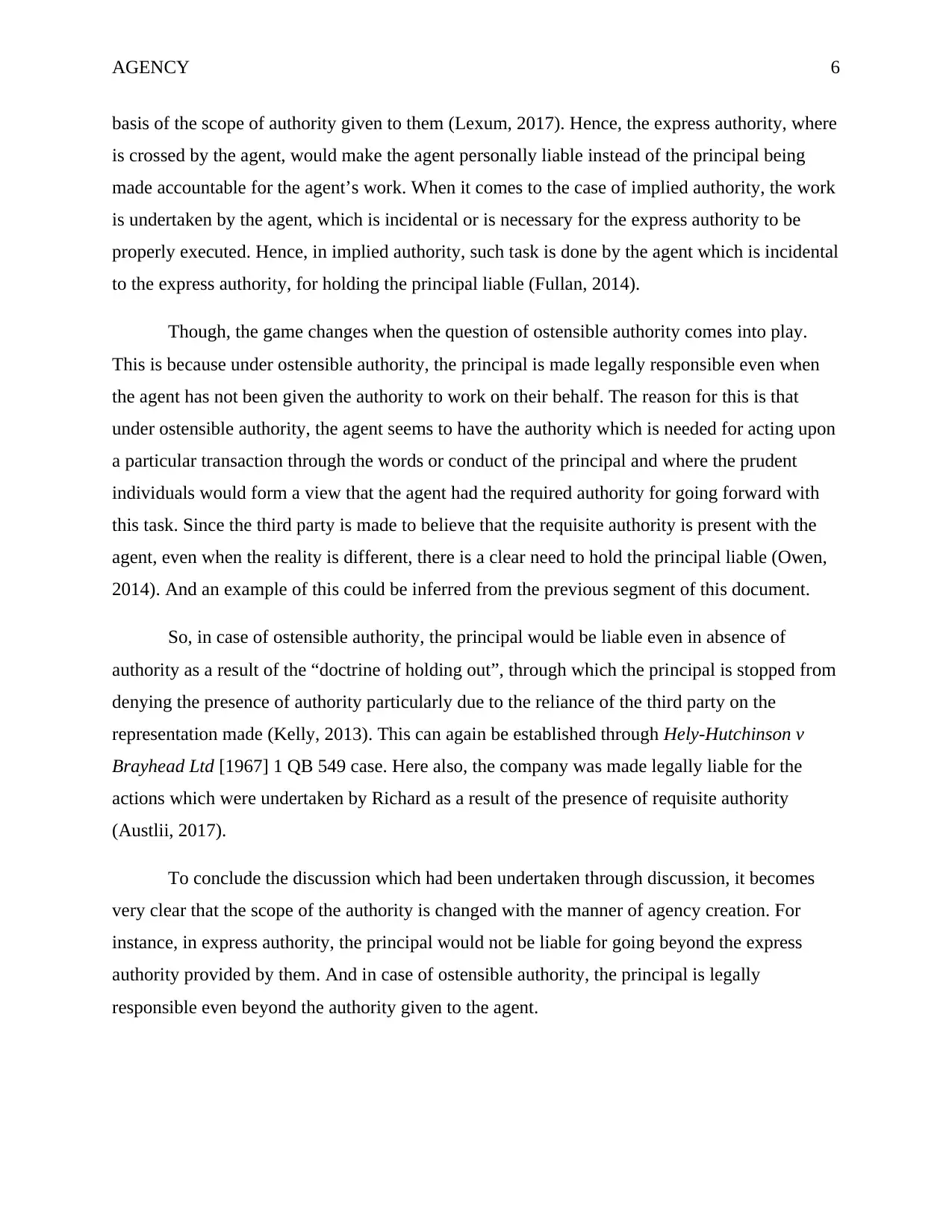
AGENCY 6
basis of the scope of authority given to them (Lexum, 2017). Hence, the express authority, where
is crossed by the agent, would make the agent personally liable instead of the principal being
made accountable for the agent’s work. When it comes to the case of implied authority, the work
is undertaken by the agent, which is incidental or is necessary for the express authority to be
properly executed. Hence, in implied authority, such task is done by the agent which is incidental
to the express authority, for holding the principal liable (Fullan, 2014).
Though, the game changes when the question of ostensible authority comes into play.
This is because under ostensible authority, the principal is made legally responsible even when
the agent has not been given the authority to work on their behalf. The reason for this is that
under ostensible authority, the agent seems to have the authority which is needed for acting upon
a particular transaction through the words or conduct of the principal and where the prudent
individuals would form a view that the agent had the required authority for going forward with
this task. Since the third party is made to believe that the requisite authority is present with the
agent, even when the reality is different, there is a clear need to hold the principal liable (Owen,
2014). And an example of this could be inferred from the previous segment of this document.
So, in case of ostensible authority, the principal would be liable even in absence of
authority as a result of the “doctrine of holding out”, through which the principal is stopped from
denying the presence of authority particularly due to the reliance of the third party on the
representation made (Kelly, 2013). This can again be established through Hely-Hutchinson v
Brayhead Ltd [1967] 1 QB 549 case. Here also, the company was made legally liable for the
actions which were undertaken by Richard as a result of the presence of requisite authority
(Austlii, 2017).
To conclude the discussion which had been undertaken through discussion, it becomes
very clear that the scope of the authority is changed with the manner of agency creation. For
instance, in express authority, the principal would not be liable for going beyond the express
authority provided by them. And in case of ostensible authority, the principal is legally
responsible even beyond the authority given to the agent.
basis of the scope of authority given to them (Lexum, 2017). Hence, the express authority, where
is crossed by the agent, would make the agent personally liable instead of the principal being
made accountable for the agent’s work. When it comes to the case of implied authority, the work
is undertaken by the agent, which is incidental or is necessary for the express authority to be
properly executed. Hence, in implied authority, such task is done by the agent which is incidental
to the express authority, for holding the principal liable (Fullan, 2014).
Though, the game changes when the question of ostensible authority comes into play.
This is because under ostensible authority, the principal is made legally responsible even when
the agent has not been given the authority to work on their behalf. The reason for this is that
under ostensible authority, the agent seems to have the authority which is needed for acting upon
a particular transaction through the words or conduct of the principal and where the prudent
individuals would form a view that the agent had the required authority for going forward with
this task. Since the third party is made to believe that the requisite authority is present with the
agent, even when the reality is different, there is a clear need to hold the principal liable (Owen,
2014). And an example of this could be inferred from the previous segment of this document.
So, in case of ostensible authority, the principal would be liable even in absence of
authority as a result of the “doctrine of holding out”, through which the principal is stopped from
denying the presence of authority particularly due to the reliance of the third party on the
representation made (Kelly, 2013). This can again be established through Hely-Hutchinson v
Brayhead Ltd [1967] 1 QB 549 case. Here also, the company was made legally liable for the
actions which were undertaken by Richard as a result of the presence of requisite authority
(Austlii, 2017).
To conclude the discussion which had been undertaken through discussion, it becomes
very clear that the scope of the authority is changed with the manner of agency creation. For
instance, in express authority, the principal would not be liable for going beyond the express
authority provided by them. And in case of ostensible authority, the principal is legally
responsible even beyond the authority given to the agent.
⊘ This is a preview!⊘
Do you want full access?
Subscribe today to unlock all pages.

Trusted by 1+ million students worldwide
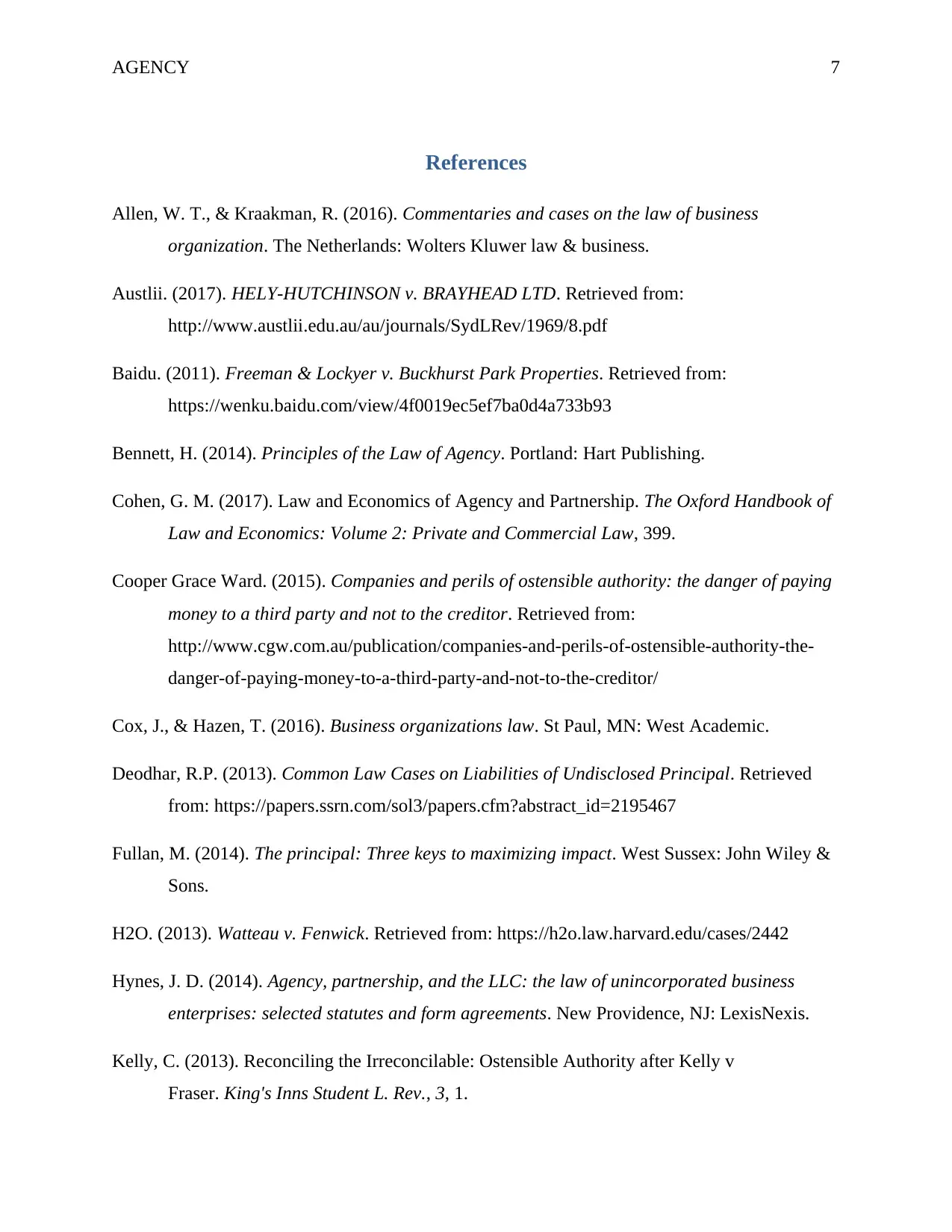
AGENCY 7
References
Allen, W. T., & Kraakman, R. (2016). Commentaries and cases on the law of business
organization. The Netherlands: Wolters Kluwer law & business.
Austlii. (2017). HELY-HUTCHINSON v. BRAYHEAD LTD. Retrieved from:
http://www.austlii.edu.au/au/journals/SydLRev/1969/8.pdf
Baidu. (2011). Freeman & Lockyer v. Buckhurst Park Properties. Retrieved from:
https://wenku.baidu.com/view/4f0019ec5ef7ba0d4a733b93
Bennett, H. (2014). Principles of the Law of Agency. Portland: Hart Publishing.
Cohen, G. M. (2017). Law and Economics of Agency and Partnership. The Oxford Handbook of
Law and Economics: Volume 2: Private and Commercial Law, 399.
Cooper Grace Ward. (2015). Companies and perils of ostensible authority: the danger of paying
money to a third party and not to the creditor. Retrieved from:
http://www.cgw.com.au/publication/companies-and-perils-of-ostensible-authority-the-
danger-of-paying-money-to-a-third-party-and-not-to-the-creditor/
Cox, J., & Hazen, T. (2016). Business organizations law. St Paul, MN: West Academic.
Deodhar, R.P. (2013). Common Law Cases on Liabilities of Undisclosed Principal. Retrieved
from: https://papers.ssrn.com/sol3/papers.cfm?abstract_id=2195467
Fullan, M. (2014). The principal: Three keys to maximizing impact. West Sussex: John Wiley &
Sons.
H2O. (2013). Watteau v. Fenwick. Retrieved from: https://h2o.law.harvard.edu/cases/2442
Hynes, J. D. (2014). Agency, partnership, and the LLC: the law of unincorporated business
enterprises: selected statutes and form agreements. New Providence, NJ: LexisNexis.
Kelly, C. (2013). Reconciling the Irreconcilable: Ostensible Authority after Kelly v
Fraser. King's Inns Student L. Rev., 3, 1.
References
Allen, W. T., & Kraakman, R. (2016). Commentaries and cases on the law of business
organization. The Netherlands: Wolters Kluwer law & business.
Austlii. (2017). HELY-HUTCHINSON v. BRAYHEAD LTD. Retrieved from:
http://www.austlii.edu.au/au/journals/SydLRev/1969/8.pdf
Baidu. (2011). Freeman & Lockyer v. Buckhurst Park Properties. Retrieved from:
https://wenku.baidu.com/view/4f0019ec5ef7ba0d4a733b93
Bennett, H. (2014). Principles of the Law of Agency. Portland: Hart Publishing.
Cohen, G. M. (2017). Law and Economics of Agency and Partnership. The Oxford Handbook of
Law and Economics: Volume 2: Private and Commercial Law, 399.
Cooper Grace Ward. (2015). Companies and perils of ostensible authority: the danger of paying
money to a third party and not to the creditor. Retrieved from:
http://www.cgw.com.au/publication/companies-and-perils-of-ostensible-authority-the-
danger-of-paying-money-to-a-third-party-and-not-to-the-creditor/
Cox, J., & Hazen, T. (2016). Business organizations law. St Paul, MN: West Academic.
Deodhar, R.P. (2013). Common Law Cases on Liabilities of Undisclosed Principal. Retrieved
from: https://papers.ssrn.com/sol3/papers.cfm?abstract_id=2195467
Fullan, M. (2014). The principal: Three keys to maximizing impact. West Sussex: John Wiley &
Sons.
H2O. (2013). Watteau v. Fenwick. Retrieved from: https://h2o.law.harvard.edu/cases/2442
Hynes, J. D. (2014). Agency, partnership, and the LLC: the law of unincorporated business
enterprises: selected statutes and form agreements. New Providence, NJ: LexisNexis.
Kelly, C. (2013). Reconciling the Irreconcilable: Ostensible Authority after Kelly v
Fraser. King's Inns Student L. Rev., 3, 1.
Paraphrase This Document
Need a fresh take? Get an instant paraphrase of this document with our AI Paraphraser
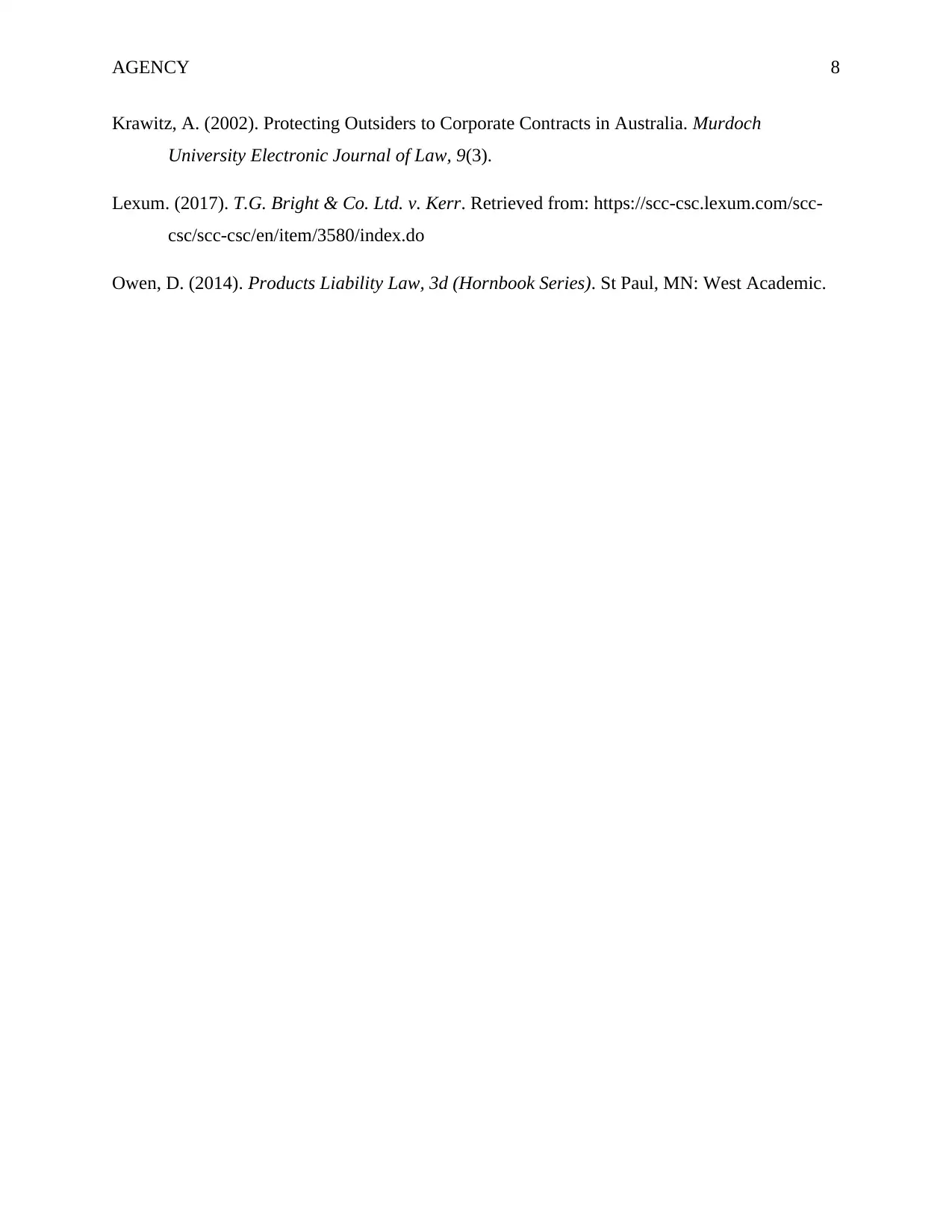
AGENCY 8
Krawitz, A. (2002). Protecting Outsiders to Corporate Contracts in Australia. Murdoch
University Electronic Journal of Law, 9(3).
Lexum. (2017). T.G. Bright & Co. Ltd. v. Kerr. Retrieved from: https://scc-csc.lexum.com/scc-
csc/scc-csc/en/item/3580/index.do
Owen, D. (2014). Products Liability Law, 3d (Hornbook Series). St Paul, MN: West Academic.
Krawitz, A. (2002). Protecting Outsiders to Corporate Contracts in Australia. Murdoch
University Electronic Journal of Law, 9(3).
Lexum. (2017). T.G. Bright & Co. Ltd. v. Kerr. Retrieved from: https://scc-csc.lexum.com/scc-
csc/scc-csc/en/item/3580/index.do
Owen, D. (2014). Products Liability Law, 3d (Hornbook Series). St Paul, MN: West Academic.
1 out of 8
Related Documents
Your All-in-One AI-Powered Toolkit for Academic Success.
+13062052269
info@desklib.com
Available 24*7 on WhatsApp / Email
![[object Object]](/_next/static/media/star-bottom.7253800d.svg)
Unlock your academic potential
Copyright © 2020–2025 A2Z Services. All Rights Reserved. Developed and managed by ZUCOL.




